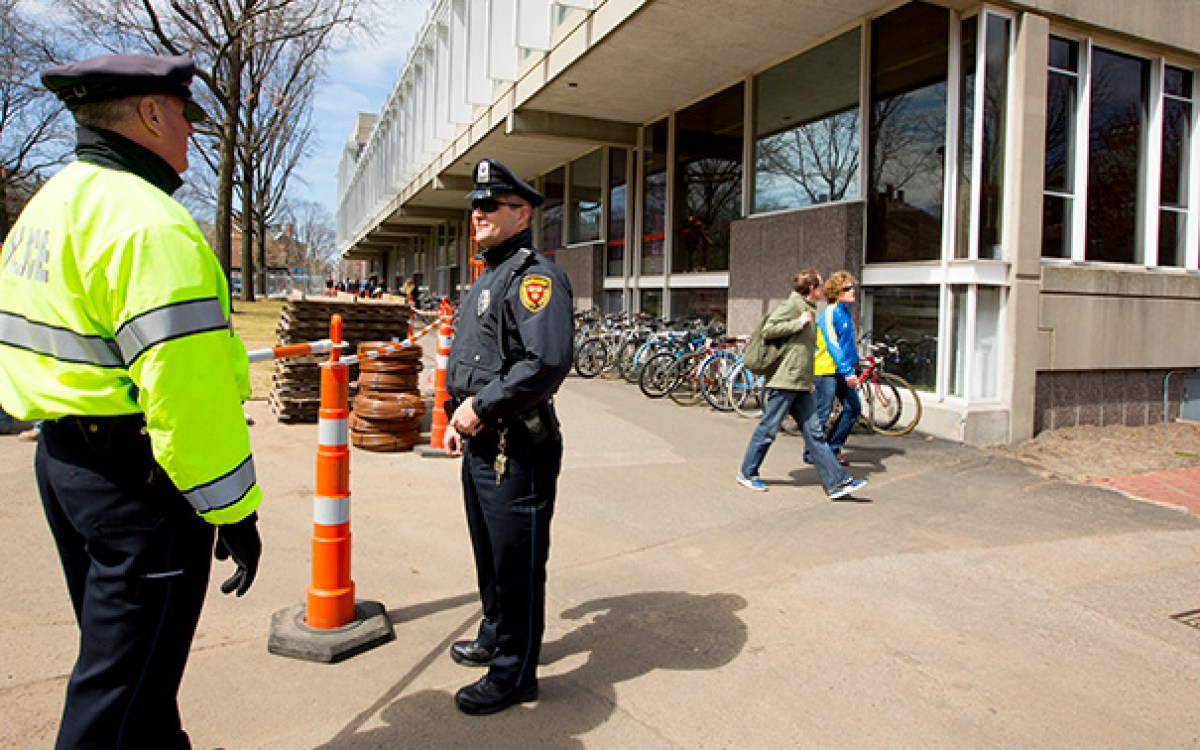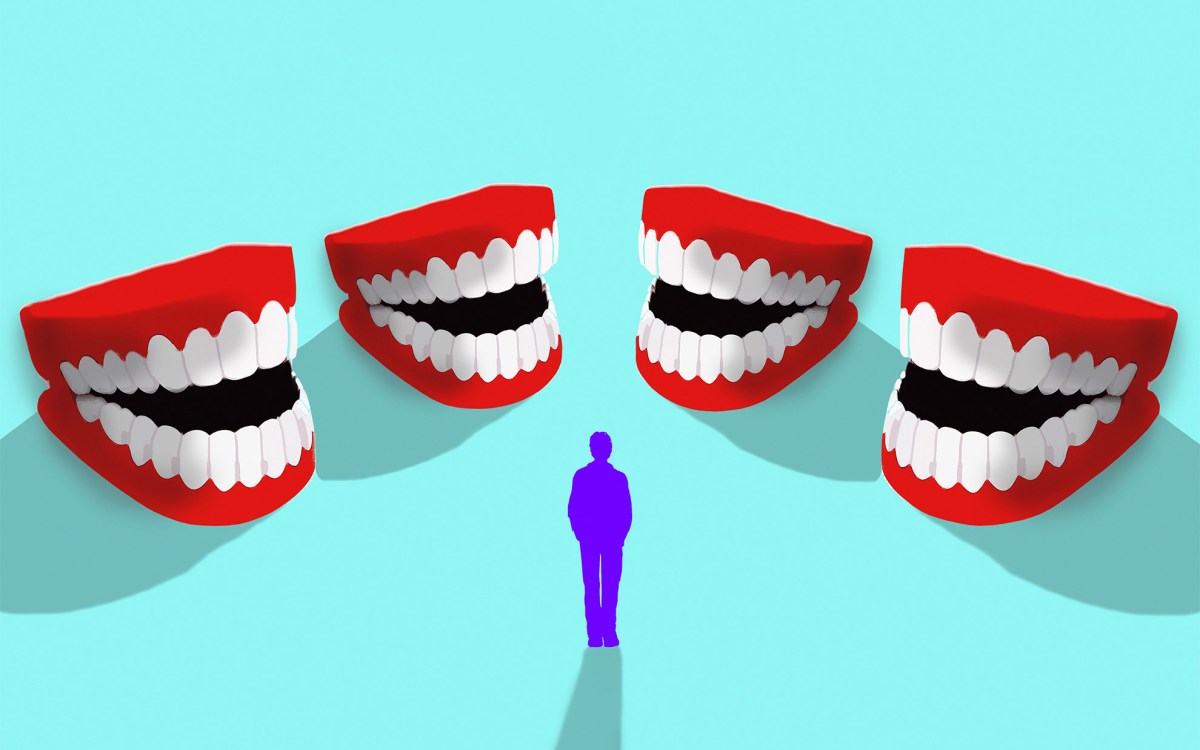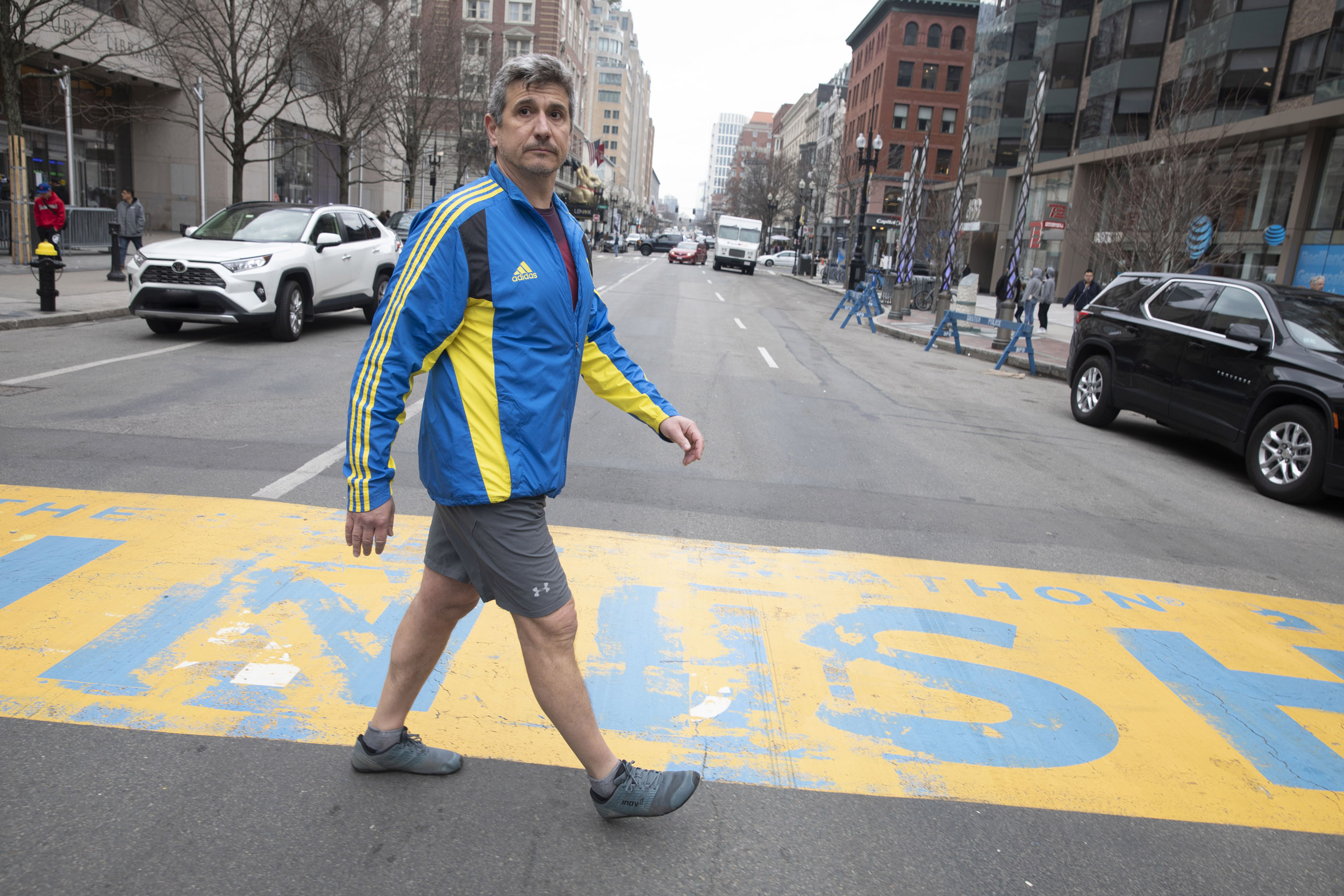
As the 10th anniversary of the marathon bombings nears, Harvard community members who ran that year recall the day’s chaos, shock, and horror. Among them is Michael Szonyi, pictured at the race’s finish line.
Kris Snibbe/Harvard Staff Photographer
Scars remain a decade later
Memories of Boston Marathon bombing still vivid for Harvard community runners, families
Madeline Cooper had just crossed the finish line when the bombs went off. Fellow sophomore Danielle Reny was in the home stretch on Boylston Street, her family nearby, cheering her on. In the miles behind, Harvard faculty, students, and other members of the community were on the course, toiling toward the finish, unaware their Boston Marathon Monday was about to take a horrific turn.
As the 10th anniversary of the 2013 Marathon bombings approaches, those with close ties to the University who experienced that day and the chaotic days that followed say that time has healed many of the emotional and physical wounds, but scars remain. No one was left untouched.
For some who ran, time has faded memories and pushed the trauma from everyday thoughts. But certain places, events, or other reminders summon flashbacks. Conversations begun breezily pause so speakers can gather themselves and sometimes brush away unexpected tears. For others, the subject remains too close to discuss publicly. A few, like Reny, whose family stood near the pressure cooker bombs, have embraced a commitment to a new cause, healing themselves by helping others, even though few days still pass without thoughts of the unexpected attack that killed three and wounded more than 260.
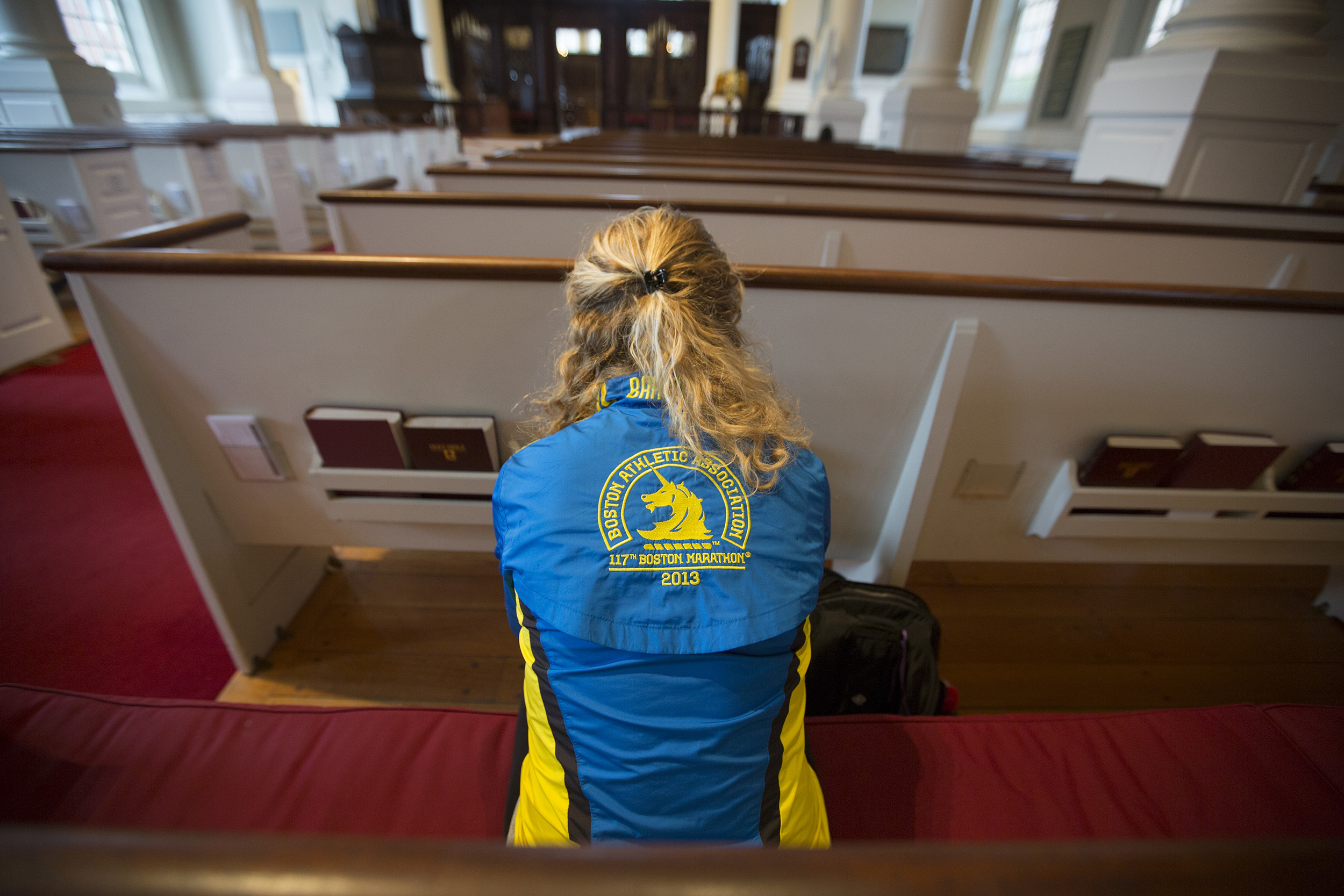
Madeline Cooper, who was a sophomore at the time of the bombings, reflects at a remembrance held a year later in Memorial Church.
Harvard file photo
For those willing to share recollections, invariably one moment is crystal clear: the instant they realized something was wrong.
Michael Szonyi was about to turn from Commonwealth Avenue onto Hereford Street, just blocks from the final left onto Boylston and the dash to the finish. But instead of accelerating to triumph, the runners slowed, the group compacting until they stopped. Word filtered back about what had happened, and Szonyi thought of his wife and 7-year-old son waiting near the finish. They’d tell him later that they’d been close enough to see the bombs go off. Szonyi also knew that, if not for the hip injury he’d cursed earlier in the race, he might have been much closer himself.
“I would have been there when the bomb went off,” Szonyi said. “I don’t know what would have happened but there might have been a very different ending to the day.”
Behind, but not far away, was Harvard College senior Mark Jahnke. He was also on Commonwealth and might have been within sight of Szonyi if Jahnke hadn’t been in the underpass beneath Massachusetts Avenue when the runners slowed to a halt. Another student, sophomore Alana Ganz, had ridden with Jahnke, Szonyi, and 45 others on the Harvard bus to the starting line that morning. Her parents had come up from Pittsburgh to support her and waited for her about 10 miles from the finish. There, her dad joined her for the push to Boston. The pair were about a mile away when everything came to a halt.
The day’s memories have two other things in common: the blue sky and sunshine of a beautiful spring day, and the utter confusion that rapidly descended. Many had left cellphones and a change of clothes in a bag to be shuttled to the finish line, now chaotic and sealed off. Runners had no way to check in with loved ones or summon a ride. Those who’d carried phones had documented the day on the long road from Hopkinton, and batteries had run down. Rumors swirled about what had happened and what might still occur. Roads were closed, both because of the race itself and later to cordon off the area around the bombing site.
Provost Alan Garber expresses pride and gratitude for the response by the University’s teaching hospitals. “Recent training in disaster management had prepared them for the casualties they encountered, helping avoid a far worse disaster.”
Harvard file photo
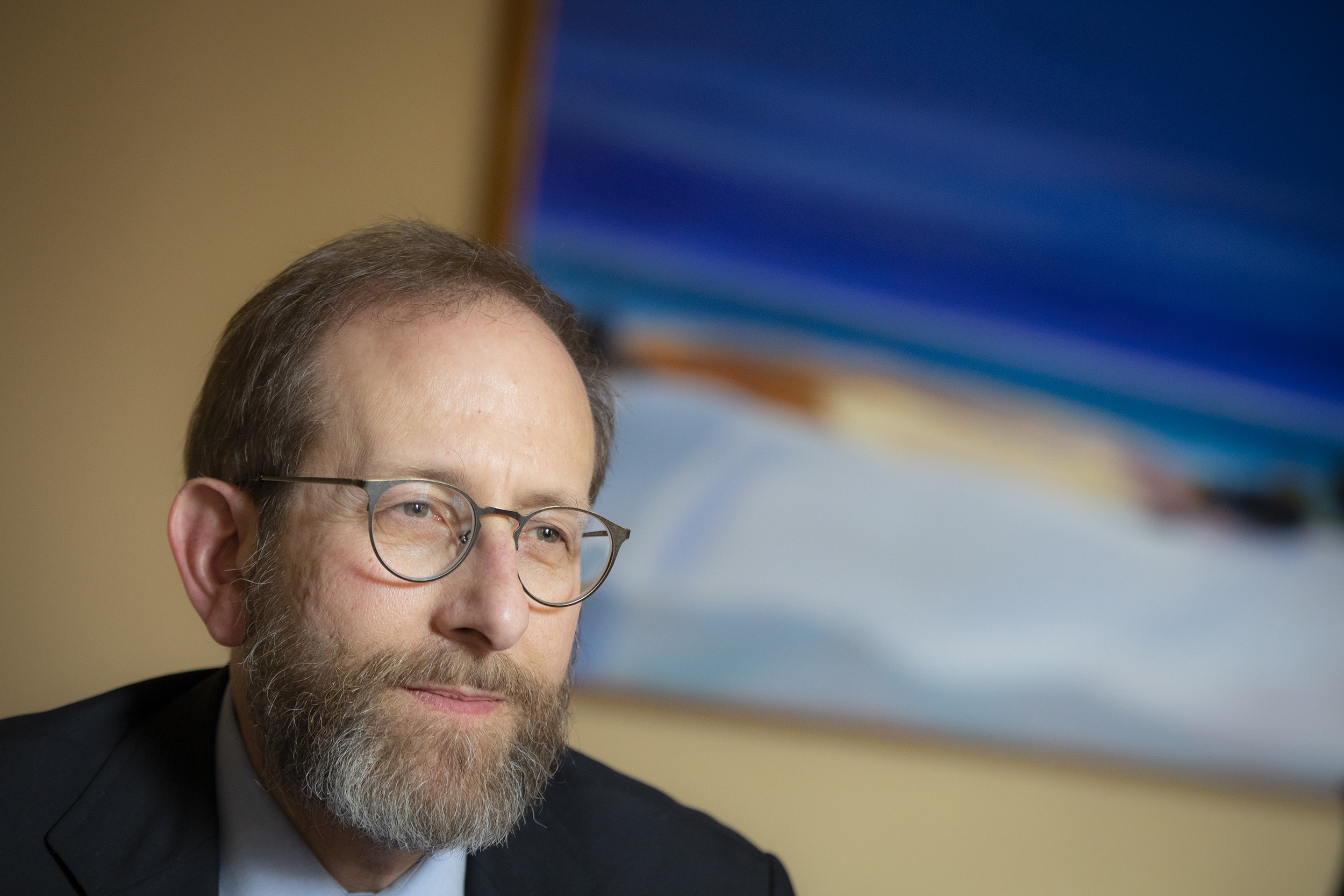
But good emerged along with chaos. People improvised, both to help themselves and others. They shared information and working phones, and even acted as guides for out-of-towners. Szonyi, the Frank Wen-Hsiung Wu Memorial Professor of Chinese History, put aside worries about his own family to translate for some Taiwanese runners whose confusion was compounded by the language barrier.
Jahnke also tried to help, reaching out to tell the Crimson he was willing to document what happened, though he was stymied by road closures and eventually abandoned the effort. As his adrenaline ebbed, Jahnke headed home, adding to the 26 miles already logged as he walked along the Charles River Esplanade to campus. He went directly to a preplanned Harvard College Marathon Challenge event that quickly became a support session. Afterward, he kept walking, heading up to the Radcliffe Quadrangle, where he could finally rest in Pforzheimer House.
“That was the greatest day of my life, until it was the worst day of my life,” said Jahnke, today a management consultant in development and global health. “I was just shell-shocked, absolutely shell-shocked.”
For two early finishers, it was only after they got back to campus that they understood the magnitude of what had happened. Harvard Provost Alan Garber and Dan Lieberman, the Edwin M. Lerner II Professor of Biological Sciences, both had finished the race already. They had walked to Public Garden and met their wives when the explosions occurred. Each marked the sounds as unusual but didn’t think much of them beyond that. The foursome hopped on the Red Line back to campus, and it was only after emerging aboveground in Harvard Square that they were deluged by texts, voice messages, and emails checking on their welfare.
“I felt such a mixture of emotions — disbelief, shock, horror, anger, grief. It is still very personal because the marathon is such a community event,” Lieberman said. “It’s for everybody. It’s a celebration of endurance and community and helping each other. The people who were injured were charity runners, running to raise money to help other people.”
For Garber, the disbelief and grief were mixed with pride and gratitude for the response by the University’s teaching hospitals.
“I learned soon after that the victims of the bombing who were brought to the hospitals all survived,” Garber said. “Recent training in disaster management had prepared them for the casualties they encountered, helping avoid a far worse disaster.”
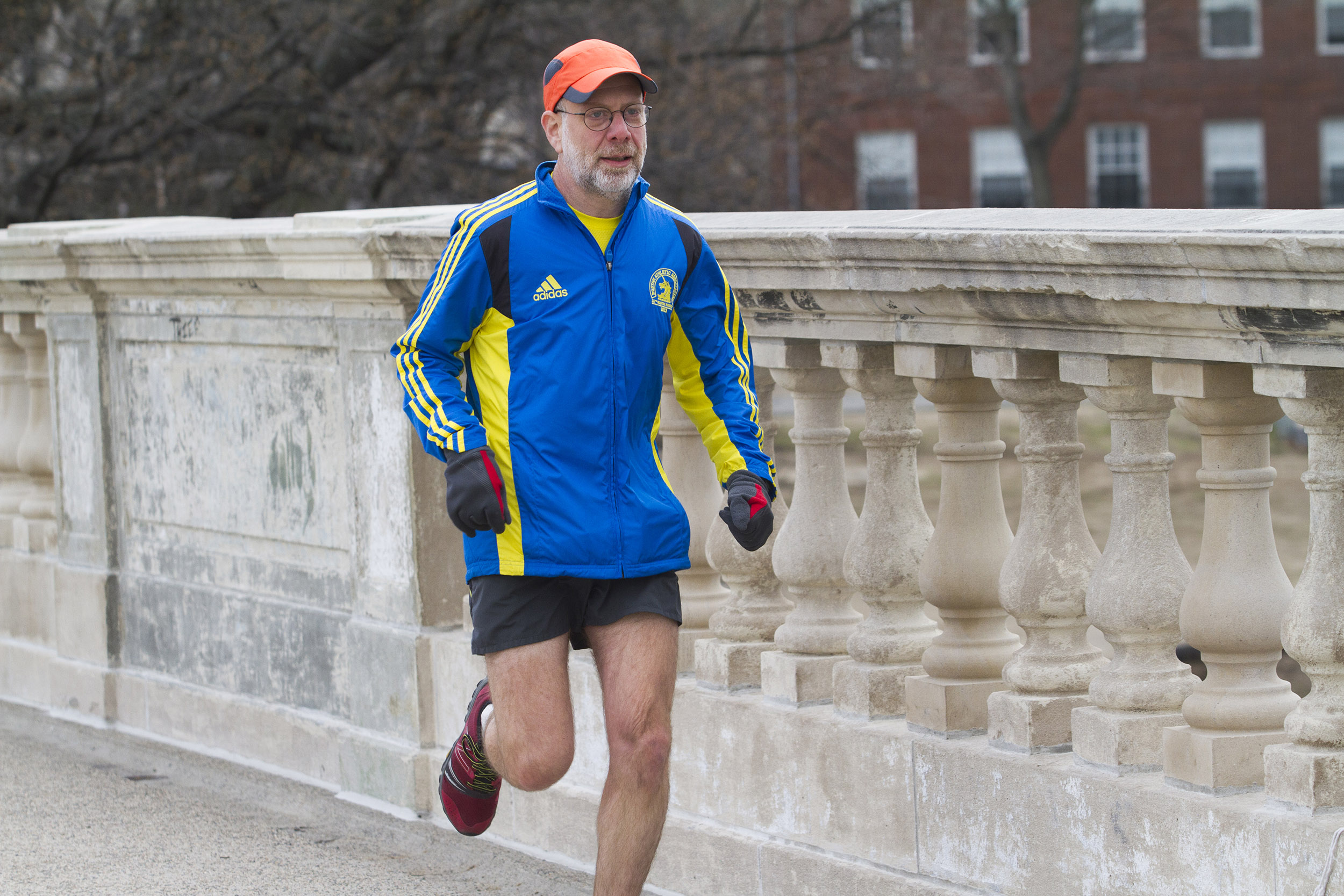
“I felt such a mixture of emotions — disbelief, shock, horror, anger, grief,” said evolutionary biologist Daniel Lieberman, pictured running on the Weeks Bridge in preparation for the 2014 marathon.
File photo by Jon Chase/Harvard Staff Photographer
Broadly, the Harvard community experienced the bombings in widely different ways. Though a number of students, staff, and faculty members were involved, running in the race or cheering from the sidelines, most were on campus.
That doesn’t mean they were spared the widespread shock and outrage at the day’s violence and disruption — and those of the days to come. Three days of nonstop news coverage ensued, reflecting the region’s struggle to understand what had happened and who had done it.
The crisis crescendoed in a regionwide manhunt after the suspects were identified. Police were in pursuit of brothers Tamerlan and Dzhokhar Tsarnaev, later found to be self-radicalized terrorists, after the two killed MIT police officer Sean Collier and kidnapped a passing motorist, who soon escaped. The older brother, Tamerlan, was killed during a gunfight with police, and Dzhokhar, now on federal death row, was captured hours later hiding in a boat in Watertown.
Those days of confusion, which included a daylong shelter-in-place order, were marked by uncertainty. Jahnke recalls holing up in his room for days after the race. Szonyi said that despite the tragedy — or perhaps because of it — he felt a duty to carry on and teach, but the exhaustion normal after the race was compounded by the hip injury. He recalls apologizing to the class for having to sit the next day and in retrospect wonders whether trying to soldier on was appropriate, given the collective trauma.

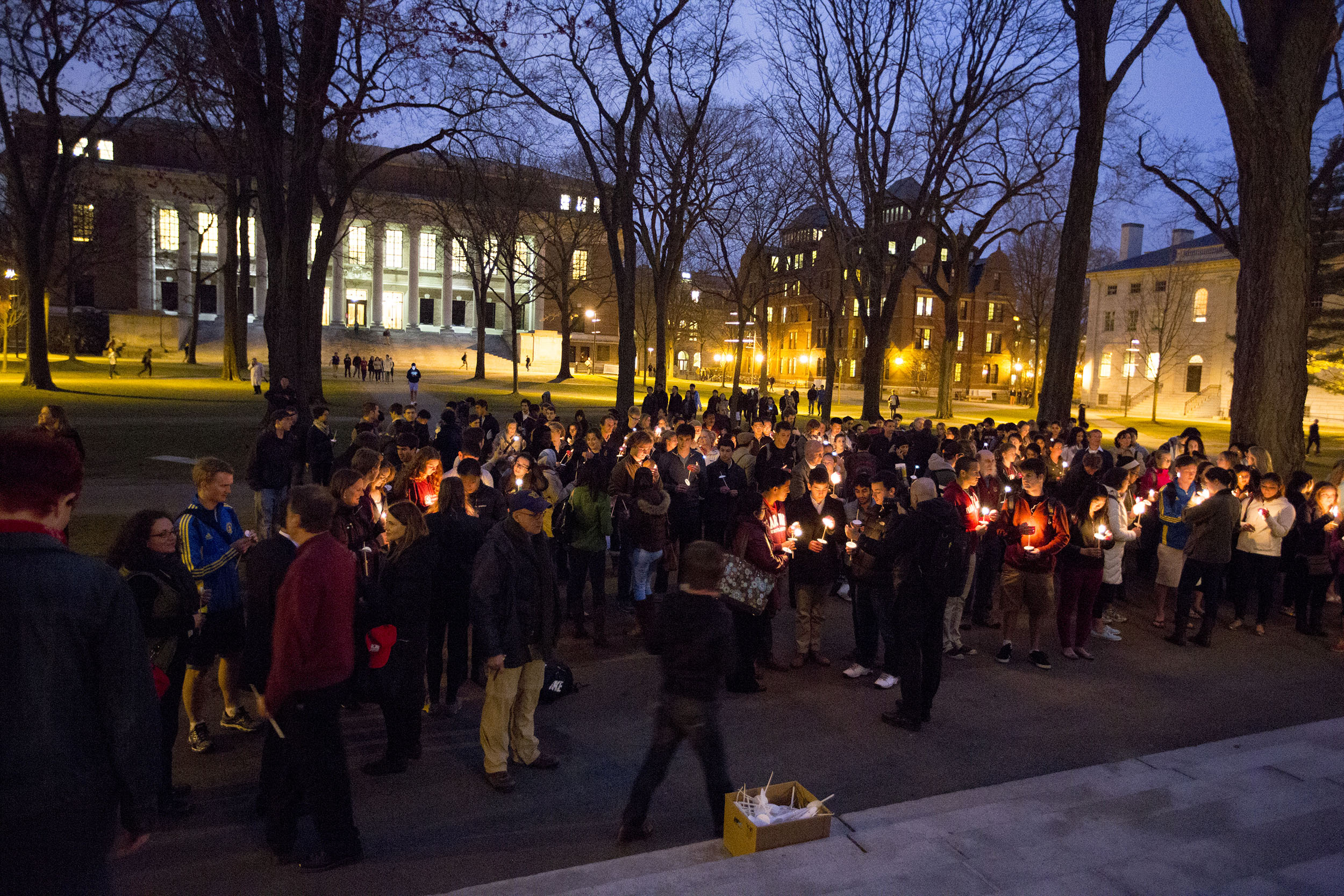
A candlelight vigil was held at Memorial Church the day after the bombings.
Harvard file photos
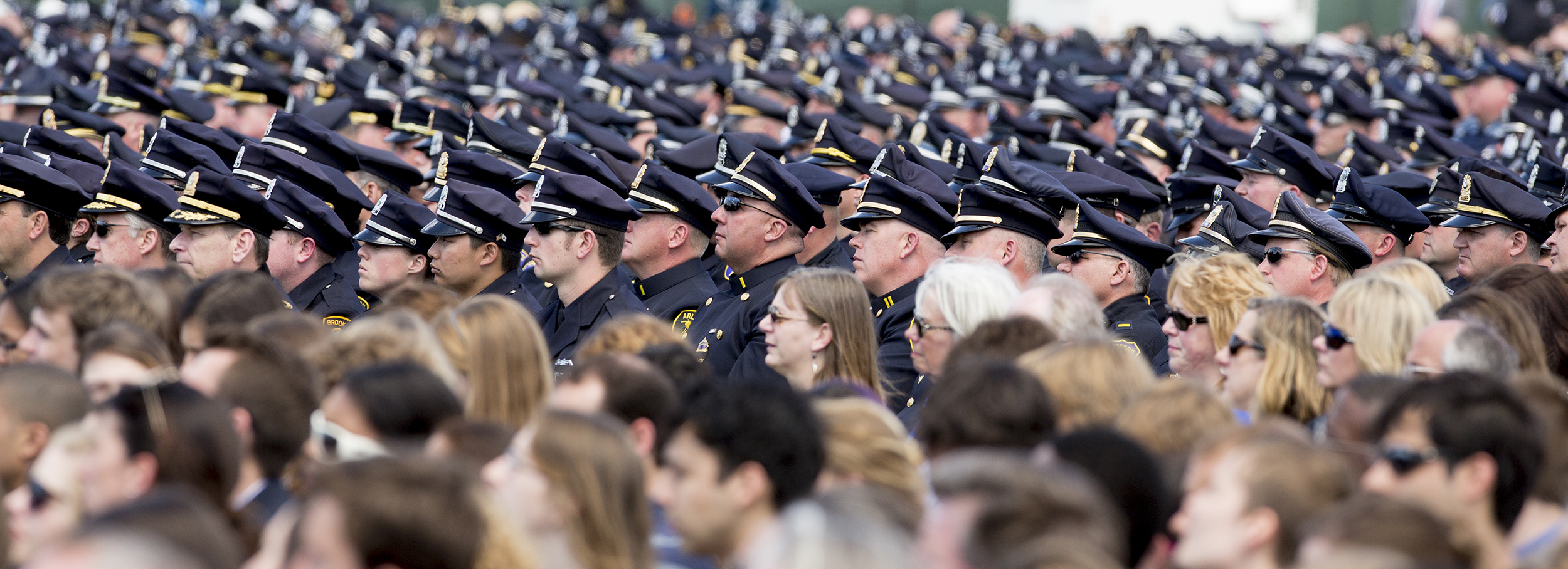
Members of Harvard’s police force were among those gathered in April 2013 to pay tribute to MIT police officer Sean Collier, who was killed by the bombing suspects during the manhunt.
Harvard file photo
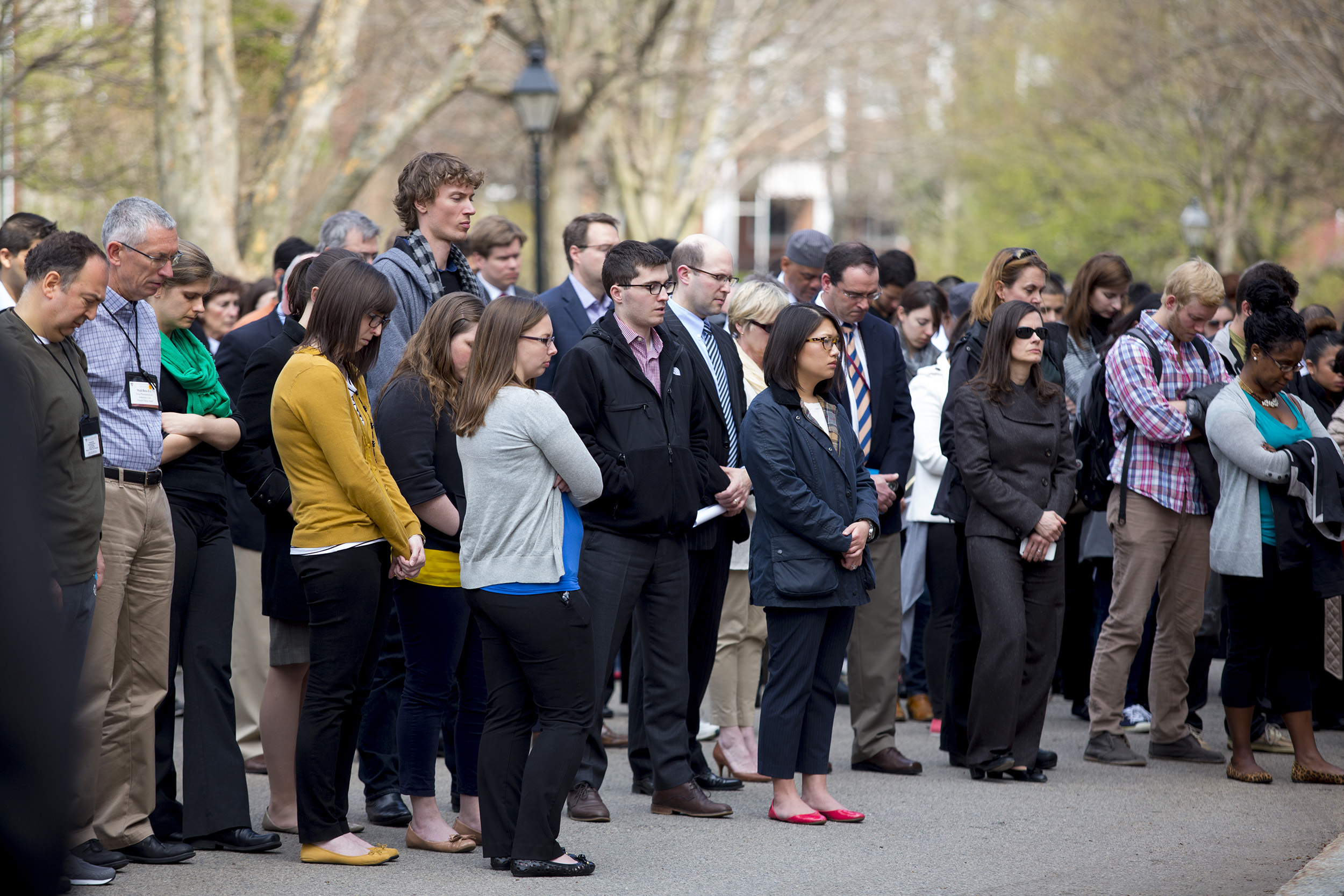
A moment of silence at the Business School.
Harvard file photo
Cooper, who heard the explosions as she crossed the finish line, managed to find her sister who’d safely finished ahead of her that day. But between the exhaustion and the chaos, the whole thing didn’t sink in until the next day, her birthday.
“I remember just walking around Harvard Square and thinking about what happened,” she said. “That was when it really settled in. It was definitely an emotional day. I called my dad, and he came in, and we got lunch and just kind of talked about the gravity of the world and how there are [bad] things that happen. I was turning 19 or something, and it was certainly a ‘loss of innocence’ moment.”
In the years since, some of 2013’s runners are still at it — Cooper among them — though many marathoning careers have converted to shorter distances.
“Over the last 10 years, I feel lucky enough that bombings are not a daily thing and that, hopefully, this will be a once-in-a-lifetime event,” said Cooper, who is studying at Stanford for her M.D./Ph.D. “There certainly is a feeling — every time I finish a marathon and there isn’t any catastrophe — of gratefulness, of having the freedom to do these things and not letting anyone or any event prevent me or anyone else from doing them.”
After the bombing suspects were caught, Harvard College Marathon Challenge runners met in the Yard for a run that would take them to the memorial for slain officer Collier at MIT and Boston’s Freedom Trail.
Harvard file photo
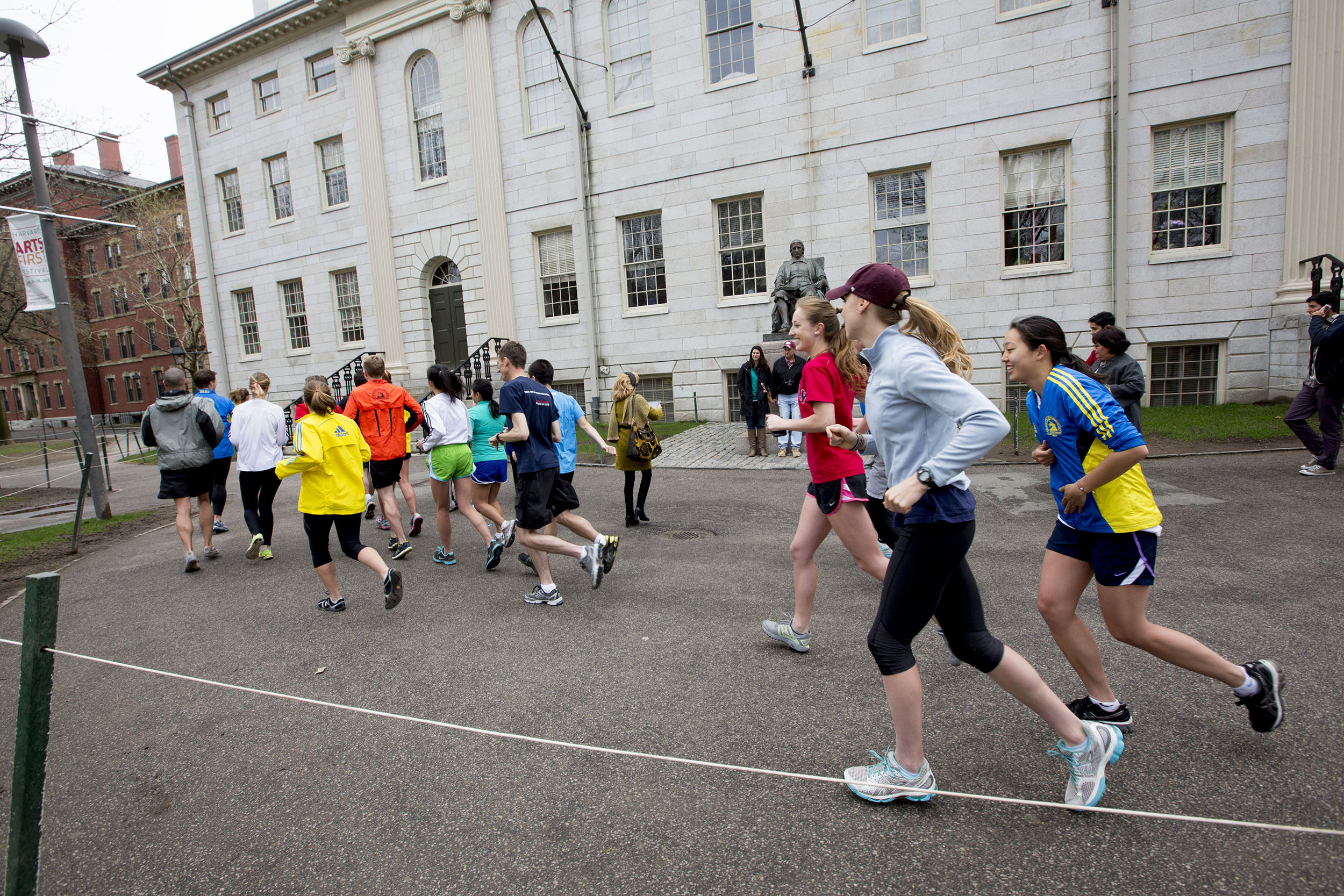
Those who ran Boston in 2014 count that year as a seminal moment. Security was tight, but Lieberman said it was a chance for closure and to finish what was halted by hate, to honor those injured and killed, and to demonstrate the community’s strength and resilience. Some of those who had been injured returned. The blue and yellow 2013 Marathon jackets were plentiful on the racecourse, as were tears when people finally crossed the finish line, a year later than expected.
“You were running by the spots — the exact spots — where those bombs had been and where those people died. And the people who were standing there knew exactly where they were and exactly why they were there. And they were there to cheer us on. It was very powerful,” Lieberman said. “I wasn’t physically at the spot at the time of the bombing, but it felt like such a violation of our community, just so upsetting that it could happen here in Boston, in our own beloved marathon. Almost the instant it was over, I felt ‘I have to run it next year. We can’t let this sort of thing win.’”
For some members of Harvard’s community, however, the memories of the bombing don’t wait to be triggered by a place or thought. It’s never far away, even 10 years on. For the families of those killed in the tragedy, the loved one’s absence is a constant reminder. Two members of the Harvard community lost a daughter and a sister when 29-year-old Krystle Campbell of Arlington died after the first bomb went off at 2:49 p.m., April 15, 2013. The family has declined to talk publicly about it.
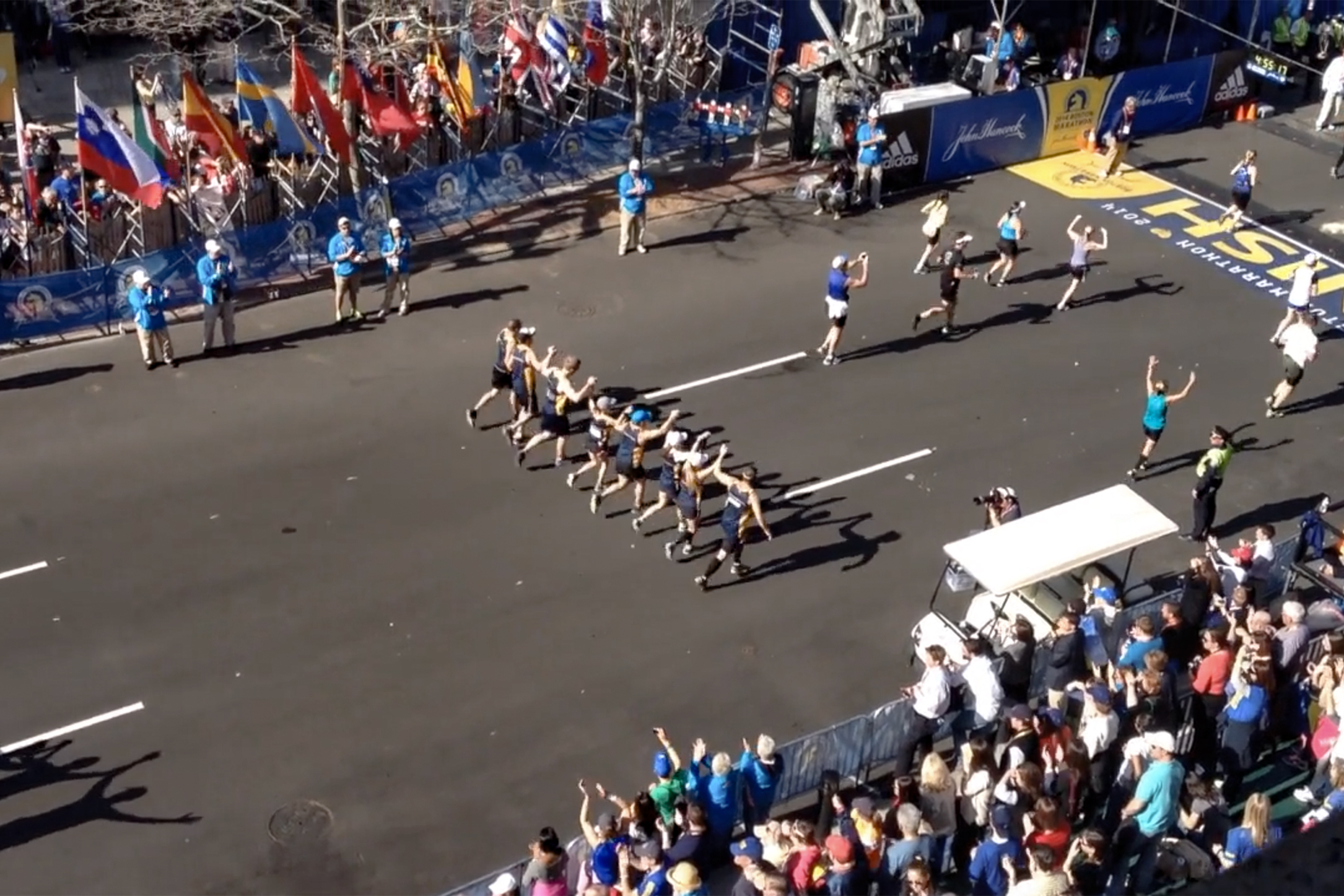
Danielle Larrow and family hold hands as they near the finish line in 2014. She was a sophomore in 2013 when the bombings injured several relatives. Since, they’ve raised almost $28 million for a research center dedicated to trauma prevention, treatment, and recovery.
Carl Prindle/Stepping Strong
Just feet away that day, Reny’s family stood at their favorite viewing spot on Boylston Street, outside Marathon Sports. For them the marathon was an annual tradition and, though considerably altered, it still is. Both of her parents had run it several times and, when they weren’t running, they joined the crowd along the route to cheer on those who were. Reny’s mother, father, grandmother, sister, and future husband — then-Harvard senior and second baseman Kyle Larrow — were looking on as she turned onto Boylston Street.
She saw the first explosion and, as many did, thought initially it was celebratory and harmless. That explanation, though, didn’t quite fit. As her mind wrestled with the incongruity, 14 seconds later the second bomb went off to her left. Through the chaos that ensued, Reny couldn’t find her family members. Worried, she made her way to her parents’ home nearby. She feared her loved ones were among the injured — or worse, among the dead. It was hours before she learned that they were all at different hospitals, injured by the pressure cooker bombs packed with ball bearings and nails. Her sister, Gillian, the most badly injured, was at Brigham and Women’s Hospital, with severe wounds to both lower legs.
Though Gillian needed extensive rehabilitation, the Brigham’s physicians were able to save her legs. In the weeks and months that followed, the Renys rallied as their wounds healed, drawing a sense of purpose from the tragedy. The next year, they ran Boston together, and eight family members held hands as they crossed the finish line. Together, they had raised more than $3 million to kick off a new research center dedicated to trauma prevention, treatment, and recovery. The family is still a driving force behind the effort, the Gillian Reny Stepping Strong Center for Trauma Innovation, at Brigham and Women’s. To date, the family has raised more than $27 million, with the Boston Marathon as their primary fundraiser. This year Danielle will run it for the fourth time.
Reny — who goes by Danielle Larrow since her marriage — still thinks about the bombing nearly every day. But, like Cooper and others who’ve found that some good can come even from an evil day, the memory’s bleakness is eased by a sense of gratitude.
“Over the past decade, my parents, husband, and I have all collectively run and crossed that finish line 19 times. Each time has been emotional but redemptive,” Reny said. “We would erase 2013 if we could, but we take great pride in how that day has inspired us to create something that is transforming trauma care for other trauma survivors like my sister.”




